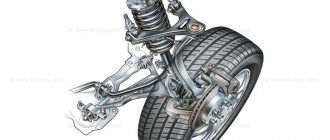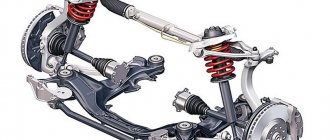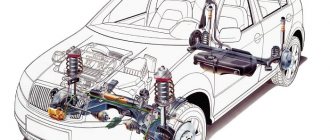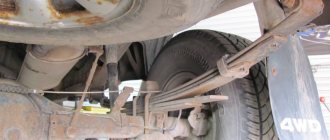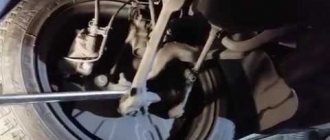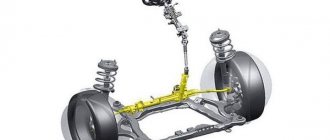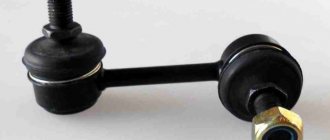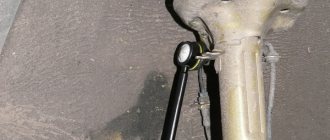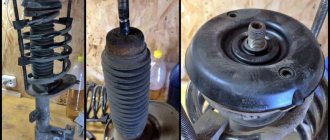One of the most important components of a car suspension is the shock absorber. The loads transferred from the road surface to the wheel are absorbed by the spring, but it is not able to immediately absorb the received energy. The spring oscillates for some time and this is a negative factor in the operation of the suspension. This drawback is eliminated by installing a shock absorber. This damping element absorbs spring energy, eliminating the transmission of vibrations and vibrations to the body.
Despite their relatively simple design, due to harsh operating conditions, shock absorbers can become unusable and stop performing their function. Malfunctions of shock absorbers are usually accompanied by the appearance of metallic knocking and rattling when driving over uneven surfaces. Moreover, this soundtrack is quite loud, so there is no need to talk about comfort when traveling.
But shock absorber knocking is the lesser of two evils compared to the consequences that a faulty shock absorber can lead to. A non-functioning part affects the handling of the car; when driving over bumps, the braking distance increases, the tires wear unevenly, and the load on the remaining components of the suspension increases.
It is impossible to indicate the exact service life of the shock absorber, since it depends on several criteria - driving style, operating characteristics of the car, and the manufacturer of the product. For some car owners they work even 100 thousand km, while for others problems arise even at 40-50 thousand km.
WE IDENTIFY THE CAUSE OF THE KNOCKING
If, when overcoming bumps in the car's interior, you hear distinct loud knocks from the wheels, it's time to inspect the suspension. You should first make sure that the knocking is a consequence of a malfunction of the shock absorbers, because third-party sounds are also created by other components, for example, the brake caliper.
First of all, it is necessary to visually inspect the damping elements. One of the main reasons for loss of performance is oil leakage due to wear of the seals. The lack of working fluid inside leads to the fact that when working on compression, the shock absorber rod does not meet resistance and it reaches the bottom of the reservoir - a “breakdown” occurs, accompanied by a strong knock.
Since the oil comes out, the marks are clearly visible on the body. Detection of fluid leaks indicates a faulty unit and the need for replacement. But it is not always possible to visually assess the condition of the damping unit. Many cars use shock-absorbing struts (MacPherson struts) both front and rear. In them, the shock absorber is placed in the strut housing and it will not be possible to inspect it without disassembling the unit.
In this case, you can use the “folk” method of checking - rocking the car. At the front of the car, you need to press firmly on the fender (at the rear - on the fender, bumper, lower trunk shelf) and release. If the shock absorber is working properly, the car body will take its initial position and stop, since the damper will absorb the energy of the spring. But if the part is faulty, the body will wobble a little after pressing and releasing.
The condition of the silent blocks must also be checked, since they can also make knocking noises. And to do this, we put the car in a pit and, using the pry bar as a lever, swing the suspension components. This inspection method makes it easy to identify wear on rubber suspension parts.
And lastly, the upper supports of the shock absorber strut (in the front suspension) are checked. They can also cause knocking noises when driving. These elements are also easy to check - we put our hand between the coils of the spring and touch the shock absorber rod, and then rock the front of the car to the sides. Vibrations of the rod during swinging indicate a malfunction of the support.
Prevention
A common cause of knocking and breakdowns is “powerful” operation. This is not about the need to choose smoother roads and drive more quietly, which is clear even without advice. Oil performs its functions not only in the engine and gearbox, but also in shock absorbers. Normally, it has a certain viscosity, depending on temperature. Car owners often, as soon as the engine has warmed up, abruptly “rip off” without thinking that the oil temperature is the same as outside the windows, and then they wonder why the shock absorber is knocking. If it is frosty outside, the viscosity of the oil increases so much that the load on it is many times higher than normal. This can break one of the most fragile parts - valve discs. This can be avoided very simply: for a few minutes after the start, try to avoid wheel impacts and jolts. Once the suspension breathes more freely, you can pick up the pace.
Shock absorbers dampen vibrations of the suspension components, minimizing the rocking of the car. In addition, the shock absorber ensures driving safety. The main function of this element is to keep the wheelsets on the road, especially when turning. The absence of a damper would lead to excessive “bouncing” of the car on every bump.
MAIN FAULTS OF SHOCK ABSORBERS
So, the diagnostics showed that everything is in order and the only place where the shocks are coming from is the shock absorber. Note that the damper produces extraneous sounds not only due to loss of tightness.
The causes of the malfunction may be:
- leakage of working fluid;
- deformation and damage to the body;
- damage to the piston rod;
- inconsistency or low quality of oil.
The leakage of working fluid has already been mentioned - this is a consequence of wear of the seals - oil seals that ensure tightness. The reason for such a malfunction lies in their natural wear (the rod is constantly moving, so the edge adjacent to it wears off over time). But the oil seal is also damaged due to corrosion, scuffing and the settling of dust and sand on the shock absorber rod.
Deformation (dents) are formed due to impacts on the damper body. Because of these dents, the rod is not able to move along the entire height of the tank and, along with the deformation, the piston rests against the defect, and this is accompanied by a strong knock. But such a problem is possible only in single-tube shock absorbers (in double-tube shock absorbers, the dent occurs on the external reservoir, while the internal one, along which the rod runs, remains undamaged).
Other options
It also happens that the listed methods do not give any results. That is, measures have been taken, but knocking in the front suspension on small bumps is still audible. Then it’s worth delving into other places that, at first glance, you wouldn’t even think about. Moreover, almost anything can knock. Therefore, we will go through rare places, sooner or later, but the reason for the knocking should reveal itself.
Engine mount
Extraneous noise can be heard when the power unit supports are worn. In this case, the engine begins to move with speed and hit the body. Many drivers immediately begin to change suspension parts, although the reason clearly lies elsewhere. For diagnostics, it is enough to inspect the elements and, based on their condition, judge the probable cause of the extraneous noise.
Video - self-diagnosis of the front suspension:
Typically, problems with the engine mount begin after the car has traveled more than 100 thousand km. Sometimes, when noise occurs, the engine begins to stall, and traces of black soot can be found on the spark plugs. In this case, a complete diagnosis of all vehicle systems will help determine the exact cause.
Brake system as an option
In some cases, a knock that seems to come from the suspension components, but in reality comes from another place. And so the driver checked the entire suspension and replaced all the components, but as luck would have it, the sound is still there. Then it makes sense to check the brakes; it is possible that the reason lies in the pads.
Diagnostics need to be done on the go and listen. If the noise disappears when braking, but returns when you release the brake pedal, then the reason is clear - it’s definitely the brake pads. By the way, sound may also appear when installing new elements. Then you should check that they are installed correctly.
CAN THE NEW SHOCK ABSORBERS KNOCK?
It happens that knocking occurs on new shock absorbers that have just been installed. Due to the fact that the parts have just been changed, they are the last to be “sinned”, looking for reasons in other suspension elements. But even new shock absorbers create extraneous sounds. There are several reasons for this - a manufacturing defect in the damper, unreliable fastening, mismatch or defective rubber bushings.
You need to buy a new shock absorber complete with bushings that fit this model.
Factory defects are rare, but this reason should not be ignored, and if knocking noises appear, even a new element should be checked. Extraneous sounds may appear due to unreliable fastening of the part in the rack housing. The element is fixed in the body with a nut and if it is not tightened enough or is loose, the damper will move along the stand, creating knocking noises.
In shock absorbers installed outside the strut (lever and semi-dependent suspensions), extraneous sounds appear due to inappropriate or depressed rubber bushings installed in the mounting lugs.
Third-party sounds on startup
Engine knocking during startup most often occurs due to malfunctions in the lubrication system.
Poor performance of the oil pump, insufficient amount of oil and clogging of the channels with pollutants leads to the fact that the oil does not have time to reach all the rubbing surfaces in time, which is why grinding and knocking noises are heard.
Due to problems with the lubrication system, oil does not flow into the hydraulic compensators, without which they begin to knock.
If noises appear during startup, it is advisable to stop the engine and check the oil level. If necessary, bring the level to the desired value.
If this does not help, you can change the oil and pre-flush the system.
Next, if the knocking noise persists during startup, you need to check the condition of the oil pump.
WE DO REPAIRS
Non-working shock absorbers must be replaced since they are non-separable. And they change in pairs. That is, if only one element malfunctions, the damper on the other side is also changed. Note that some car enthusiasts repair the shock absorber by cutting off the rolling of the housing in order to remove the rod with the piston. This operation allows you to replace the oil seals, install a new rod with an intact piston (from the donor), and fill in new oil. During assembly, tightness is achieved by welding the rolling area.
But restoring the functionality of an element is a labor-intensive process; it is easier to buy new dampers and install them instead of worn ones.
While driving, did a knock suddenly appear in the area of the stabilizer struts? Or do they rattle when turning? One way or another, the mechanism needs to be checked. We'll tell you how to do this below.
Purpose of stabilizer struts
When designing suspension, car designers look for a compromise between comfort and road stability. Excessive rigidity adds safety, but turns the car into a vibration tester. Too soft, comfortable suspension leads to dangerous rolls when entering a turn.
Stabilizers are designed to combat this phenomenon. The device is a spring beam that works in torsion. If one wheel is pressed against the body (frame), with the help of a stabilizer, the same force acts on the second wheel, compensating for the roll.
Operating principle of the anti-roll bar
Racks are used to connect the suspension elements to the stabilizer (shown in red in the figure).
Measuring distances and sizes
One of the simplest and most accurate ways to determine the presence of a malfunction is to measure the gaps and dimensions. The optimal solution: take it to a service station. Qualified technicians will definitely help determine whether replacement is necessary. It must be remembered that even one faulty shock absorber affects the efficiency of the vehicle’s suspension system.
It must be remembered that working with a stand in a workshop implies the need to configure it for a specific car. For example, it often happens that the data indicated almost complete wear of the car’s suspension. At the same time, on the road, regardless of speed, the car behaved perfectly. The reason was simple: the stand was simply not configured to work with a rigid suspension.
Read also: Mounting a radar detector on a torpedo
Mechanism design
This component is designed for a reliable and at the same time damping connection of the unsprung masses of the suspension (wheel, hub, steering knuckle) with the elastic part - the stabilizer beam. The common purpose of the stand is to provide a movable joint. In this case, the execution may be different:
- Ball joints. The most common scheme. Provides freedom to hinges in all directions.
Example of ball joints
With this design, wear occurs the fastest, since the ball joints take on a load comparable to ¼ of the vehicle’s weight. The stand is constantly in motion, experiencing forces aimed at compression, tension and bending. It is used in suspensions where the components are arranged compactly and the stabilizer beam has a complex shape. Can be installed at an angle. Practically beyond repair or restoration.
Earrings. A primitive but very reliable scheme.
“Earring” type design
Elastic elements (rubber, polyurethane, silicone) are threaded onto the pin and secured with washers. Between the rubber bands are the eyes of the suspension arm and the stabilizer beam. Some freedom of movement is provided by the rubber stops themselves, but significant deviation from the vertical is impossible. This drawback does not allow the use of such racks in complex suspensions. The advantages include the ability to withstand significant loads and high maintainability.
Silent blocks. Such a hinge has mobility in only one plane. Transverse deviations are allowed at a small angle.
Option for silent blocks (detail circled in red)
The advantages include a longer service life (compared to ball joints) and relative maintainability. Disadvantage: limited use on complex suspension structures.
How to check: diagnostics at home
Attention! The general rule for diagnosing suspensions is to look for faults in an unloaded state. The hinges, compressed under the weight of the car, may not show any play.
An assistant may be needed to carry out the diagnosis.
Necessary tools for performance testing
- Jack. Designed for lifting and suspension manipulation purposes only. It is dangerous to carry out work when the car is supported only by a jack!
- Support stands for the bottom (frame).
- Wheel chocks.
- A pry bar or a small crowbar.
- It is advisable to have a car enthusiast's stethoscope. Without the vehicle moving, knocks in the suspension are not so pronounced; sometimes they can only be detected with the help of a stethoscope.
Using a car stethoscope, you can listen not only to suspension malfunctions, but also to engine noise.
How to check the serviceability of parts
- Inspect the geometry of the racks. Abnormal bends are a sign of a malfunction, and driving on such ones is not recommended.
- Carefully examine the condition of the front hinges. Torn ball boots, cracks in silent blocks or rubber bushings indicate critical wear.
- While under the bottom of the car (in the pit of the garage), ask an assistant to rock the body with his hands. Obvious knocking noises will be noticeable, and it will not be difficult to find out the malfunction.
- Unload the suspension. To do this, lift the car with a jack and place it on support stands. The wheels should not leave the ground. Both sides should be lifted, otherwise the elastic beam will twist. Pull the racks with a sharp movement - the play will be noticeable. Use a stethoscope for an accurate diagnosis.
How to find out the cause of knocking noises: video guide about the easiest diagnostic method
Front suspension. What might be a concern?
- Wheel bearings.
Wheel bearing noise can be detected by ear even by a less experienced driver. It howls and rustles when moving and, gradually increasing, begins to drown out all other noises in the cabin. To make sure that it is the bearing that is making noise, you need to turn the steering wheel a little when driving at speeds above 60 km/h. If the rumble appears in one steering position and stops in another, it means the bearing has definitely failed. You can also check this by lifting the car wheel and spinning it. If you hear a characteristic rustling sound, it means the bearing needs to be replaced.
- Stabilizer's pole.
Stabilizer links are the most vulnerable part of the suspension. Due to the poor quality of roads, they often fail and begin to produce a slight but constant noise from under the bottom of the car. You can determine if the struts are broken by resting the lever on the subframe and shaking the stabilizer. If during these actions a knock is heard and play is felt, it means that the stabilizer links are out of order.
These parts are usually replaced in pairs, and you can do it yourself. To do this, you need to hang the front wheels of the car, and using a 16 wrench, unscrew the hinge nuts, while holding them with a 5 hex wrench on the back side so that the hinges do not turn.
- Spherical bearing
The sound of a broken ball joint can be difficult to distinguish from other suspension noises. You can check the play of this unit by moving the suspended wheel in a horizontal plane. If the fault cannot be determined, you can insert a pry bar between the subframe and the lever and press on the resulting stop. This is the easiest way to identify a loose ball pore.
At the service center, the ball joint is replaced along with the lever and silent blocks. But these parts also exist for sale as a separate unit.
Replacing a ball is not an easy operation, so you can tackle it yourself only if you have the necessary tools and metalworking skills.
- Shock absorber.
Many drivers complain about the knocking of Lada Vesta shock absorbers, but their design itself eliminates this possibility. The telescopic strut consists of two cylinders that dampen vibrations while moving on uneven roads. When they break down, the car begins to “sit down”, the road holding is poor, all the unevenness and bumps become clearly noticeable, and the steering deteriorates. In this case, the outflow of liquid or gas from one cylinder to another is disrupted, and the shock absorber rod begins to make characteristic sounds that resemble knocking.
Visually, a breakdown of the oil shock absorber can be determined by drips on the casing, in the presence of which the part must be replaced immediately. You can also rock the car, focusing on the hood. Under normal conditions, after the impact ceases, the machine should swing once and stop moving. If this does not happen, the racks do not absorb as expected.
- Upper rack support
The upper mount of the front shock absorber contains a support bearing that can knock and howl when driving. You can identify a malfunction of this unit in the following way: swing the car in a vertical plane and put your hand on the support. If a part malfunctions, rattling and humming will be felt.
Another method requires completely dismantling the rack. This check can be done simultaneously with replacing the front shock absorbers. After removing the steering knuckle, you need to rotate the strut together with the spring in a circle. The crunching and grinding sound in the upper part of the assembly that occurs during this indicates that the support is faulty.
Like shock absorbers, it is advisable to change the upper supports at the station, since the process of dismantling and installing them is quite complicated.
Do-it-yourself restoration and repair (with photo)
Faulty racks should be dismantled. This procedure is performed with a standard tool. You may need a ball joint remover. Depending on the design of the rack, it should be replaced or repaired.
- Ball joints are practically irreparable. There are repair mixtures that are injected into the hinge and, when hardened, eliminate the play. This method is questionable, the effect will be short-lived.
Advice! To prevent wear of the stabilizer ball joints, the boots should be checked regularly. If a crack or tear appears, the rubber should be replaced.
The choice of bushing material depends on the driving style and the owner’s love for comfort
If you don’t have the necessary bushings, you can find suitable bushings in the car market that are suitable in diameter and thickness. It is important to remember that the rubber bands are designed for a certain weight of the car. The same applies to replacing material. Polyurethane has a longer service life, but is harder than rubber. You can lose in comfort. When replacing the support rubber bands, you should thoroughly clean the seat (eye). Sand and dirt contribute to wear.
Silent blocks are somewhat more difficult to change, but independent repairs are still possible.
Pressing silent blocks can also be done using homemade devices
If there are ready-made repair kits, that’s good. If not, choose the appropriate diameter. It is important not to make a mistake with the diameter of the hole in the metal bushing, otherwise the stand will hang on the support pin. Dismantling and pressing of the silent block can be done with a homemade press based on a jack.
You will need a hydraulic jack for this work.
Important! The installation of restored racks has its own peculiarities. Secure (but do not tighten) the mounting nuts and lower the vehicle to its normal position, then perform final tightening. More details about the installation are described here.
If the stabilizer struts are not suitable for repair, they should be replaced with new ones. You can read more about replacing stabilizer struts here.
Self-diagnosis and repair of stabilizer struts is not difficult for an experienced car enthusiast. By servicing your car, you not only save money. Familiarity with the design adds confidence during operation; you will not be taken by surprise on a long journey.
The appearance of noise and knocking while driving is a sign of malfunctions and breakdowns in the vehicle's chassis. Further driving by car can end quite disastrously. If you can determine the source of the knock in the front suspension, then many breakdowns can be repaired yourself.
There are many sources of unpleasant sounds in the front suspension, and not all of them are to blame for the suspension and damping system. Worn parts of the steering system, brakes and even the engine can rattle. This is why comprehensive vehicle diagnostics are required.
Calipers
What can knock in the front suspension on small bumps
Each car model may have its own reasons for the caliper knocking, it all depends on their design features, but there are also similar reasons that we will focus on.
1. Anther.
This is what is checked first. If the boot is torn, the lubricant will quickly leave the guides and they will run dry. Read below for what to do with worn fingers.
2. Caliper pin.
It is inserted into the bracket and must be lubricated with high-temperature grease, for example, special for calipers or CV joints.
On the VAZ 2110, Priora, Kalina, Grant, 2114, two guide pins are structurally provided, upper and lower.
In the absence of lubrication or severe wear of the bracket holes or pins, the latter begin to knock on bumps.
To fix the problem, it is necessary to apply fresh lubricant to the parts, and if they are severely worn, replace them with similar ones from the repair kit, which is sold separately.
The new repair kit for the above VAZ models includes one guide pin with a bolt and boot. Accordingly, two repair kits may be needed.
But there are cases when the new fingers are 0.5 mm thicker than the standard ones, so you have to bore the caliper bracket to solve the problem.
READ ON THE TOPIC: Other characteristic malfunctions of the VAZ 2110.
Sources of knocking in the steering system
Oddly enough, but often the culprit for knocking in the front of the car is individual parts of the steering system. The hinge joints in the tie rods and ends wear out over time and gaps appear in them. Because of this, noises and knocks can be clearly heard when driving on bumpy roads.
- To check the serviceability of the steering tips, you will need an overpass or inspection hole. In some models, you can reach the steering tip from the outside of the wheel. For diagnosis, it is better to use the help of a partner. Its task is to turn the steering wheel left and right with sharp short movements. At this time, you should place the palm of your hand on the tip - the presence of play will be transmitted by a knock on the hand. Additionally, you can grab the tip and lift it up and down; even slight wear can be felt with this diagnosis.
- Similarly, the condition of the steering rods should be assessed. Holding the rod with his hand, the motorist will feel the presence of gaps in the articulated joint. In addition, strong and sharp movements from the wheel to the steering rack and back can confirm the presence of wear on the part.
To replace the tie rod and end, you will need a special puller and a set of box and open-end wrenches. Before work, you should clean the parts from sand and dirt, and then treat the detachable connections with a “liquid” wrench such as WD-40.
Testing at the stand
If you cannot be completely sure of the correctness of your conclusions about the proper operation of the shock absorber struts, contact specialists who will perform diagnostics on a vibration stand. Of course, you will have to pay some money for this, but thanks to the test at the stand, you will be able to get an expert opinion and precise instructions for action. If, of course, you contacted a trusted car service center.
To avoid wasting your money, follow these simple guidelines:
- Check whether the technicians have configured the computer to diagnose exactly your make and model of car (the settings are individual for each car);
- It is necessary to take into account the age of the car, since the weight of the body changes over time, so the settings and standards will have certain deviations;
- Before bench testing, check your wheel alignment and tire pressure;
- Go only to a reputable service.
Checking shock absorber struts is not at all as simple as it seems; it is a troublesome and time-consuming process, where you need to take into account every detail, every little thing.
Causes of knocking in the brake system
Some causes of knocking in the front suspension are often hidden in the brake system. Sometimes you can determine the malfunction while driving the car. If the knocking noise disappears when braking, but after releasing the brake pedal it appears again, then you need to look for the problem in the brake pads.
To definitively identify the breakdown, you need to jack up the car and remove the wheel. After this, you should turn out the brake disc with the hub and caliper. Upon external inspection, it can be seen that the lining has peeled off from the brake pad (often it cracks and crumbles).
Such problems can arise immediately after installing new brake pads from an unknown manufacturer. As a result, savings result in additional costs. It is necessary to purchase the pads again and replace them.
To identify the cause of a knock in the suspension, it often takes a lot of time. But you will be able to find a worn-out part that you can replace with your own hands. Then, when driving on a bad road, noises in the front suspension will not disturb the car owner.
Car front suspension
Half shafts If the hum increases with increasing speed, then they are faulty. The axle shaft itself does not break, but it has a weak point - the bearing. Within 3 weeks it is necessary to repress it or replace it along with the axle shaft.
CV joint If the CV joints (grenades) are faulty, clicks will be clearly heard when turning. Especially if you turn the steering wheel from side to side at idle. In this case, urgent replacement is required.
Removing the CV joint from the axle shaft
Ball joints. If there is a malfunction, they creak or knock when driving on uneven roads and bumps. It is necessary to replace them as quickly as possible, otherwise the car will end up in the middle of the road, with the wheel unnaturally turned out.
Wheel bearings. Front wheel bearings can produce both knocking and noise. The noise occurs as a result of wear of the bearing rollers and the separator raceway, and the knocking occurs from strong play in the bearings. It is not difficult to make a diagnosis yourself. To do this, you need to jack up the left side of the car and sharply turn the wheel. If there is a hum that sounds like a metal ball rolling on a sheet of metal, the bearing needs to be replaced. Next, grab the upper inner section of the wheel with your left hand, and the lower outer section with your right hand. Now you need to shake the wheel “to the point of breaking”. If it “lobs” even a little, contact a specialist to eliminate the play in the hub bearing, otherwise its service life will be halved.
Steering. You should start with the gearbox, which sometimes knocks as a result of wear on the main pair and creaks when turning the steering wheel in different directions. As a rule, the problem is solved by lubricating and adjusting the steering shaft. And the steering ends and rods knock like ball joints, and the knocking only appears on rough roads. They urgently need to be changed.
Shock absorbers. As a rule, they do not bother you with “sounds,” but if sounds are still present, you can clearly hear them on an uneven road: they squeak and knock. Their disease is wear of cushions, rubber bushings, and oil leakage. You need to rock the car (press on the trunk and fenders) and listen for knocking noises. If the body continues to sway even after you stop the impact, it means the bushings and cushions are worn out. Driving on such shock absorbers is dangerous, because when you press the brakes sharply, the braking distance doubles. In addition, the cause of the breakdown may be an oil leak from the shock absorber, which is noticeable to the naked eye (you will see adhered dirt and smudges on the body). This shock absorber needs to be replaced.
Springs. Unpleasant sounds of rubbing metal elements are often produced by springs. The reason is incorrect installation - to fix the problem, you should contact the specialists who installed them.
Brakes. Brake pads sometimes whistle when the pedal is applied, even to the point of grinding. If the pads are new, most likely they just haven’t gotten used to it yet, and the noise will disappear after 1-2 thousand kilometers on its own. However, there is a risk that they are crooked, that is, defective. Therefore, if the sound does not disappear after some time, and the car changes trajectory when braking (it pulls to the right or left), the pads should be replaced. On cars that are expensive to maintain, they are quite expensive, so the problem can be solved in another way: remove the brake disc and sharpen it on a machine, and process the brake pads using a grinding wheel.
